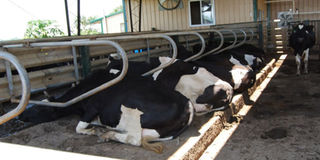Where you will find indigenous, exotic and crossbreed cattle in Uganda

Cows resting after milking on a dairy farm in Gulu. Though the north has the least number of cattle, smallholder dairying is being discovered as a strategy for improving livelihoods. PHOTO BY CISSY MAKUMBI
The Seeds of Gold fifth farm clinic, which is themed on dairy farming, is slated for This Saturday October 1 at Makerere University Agricultural Research Institute Kabanyolo (MUARIK). Dairy farmers will be trained on feeding for best yields, dairy economics and product management, best animal breeds, milk handling, pests and disease control as well as value addition.
Population
According to various reports, the cattle population has been skyrocketing in the past two decades with the largest section—both indigenous and crossbreeds—found in western Uganda.
For instance, in 1991, total cattle population was 3.35 million, in 2005 a national household survey estimated it at 7.5 million, and by the 2008 national livestock census, it was 11.4 million. A third of the herd is exotic/crossbreed and the rest is indigenous cattle.
The central region has the highest number of indigenous cattle at two million (31.5 per cent) followed by eastern region at 1.6 million (26.6 per cent), western region with 1.4 million (22.6 per cent) and northern region at 1.3 million (20.3 per cent).
A comparison of households that reared indigenous cattle at national level shows that there was increase from 19.6 per cent in PHC 2002 to 26.6 per cent in UNHS 2005. PHC is the population housing census while UNHS is the Uganda National Housing Survey.
Central and eastern region registered the highest percentage increases from 3.8 per cent to 6.9 per cent and 7.2 per cent to 10.1 per cent respectively.
Increases in north and west were minimal, with the former attributed to civil strife.
Out of the one third exotic/crossbreed cattle, 0.89 million (70.7 per cent) was in the west followed by 0.19 million (15.7 per cent) in central while the north had the least number at 0.022 million (1.8 per cent).
Brian Arinaitwe, the coordinator, East Africa Dairy Development Project, the increase of cattle population is an indication that more people who are embracing dairy farming.
“You heard recently about an abattoir which will be slaugthering about 100 cows daily. This means we need more cows and the increase is better,” he said.
Early this, President Museveni opened Egypt-Uganda Food Security Company in Bombo, Luweero District.
The facility serves as an abattoir and is soon expected to open a tannery for skins and hides.
However, Arinaitwe says the increase is largely of indigenous cows, and calls for strategies to boost exotic breeds.
Increase
In the 2008 national livestock census conducted by the ministry of agriculture, the number was put at 11.4 million which means there was an increase of nearly four million in three years, that is from the 7.5 million in the 2005 survey.
Of this, 2.5 million (22.3 per cent) was in the west, 2.5 million (21.8 per cent) was in the east, 2.5 million (21.7 per cent) was in central region, Karamoja had 2.3 million (19.8 per cent) and the rest of the north had 1.6 million (14.4 per cent).
It was indicated that the indigenous cattle were 10.6 million, representing 93.6 per cent of the total herd.
A regional breakdown of the figures showed the east had the highest number of indigenous cattle at 2.35 million (21.8 per cent), while the west had the least number at 2.22 million (20.7 per cent).
For exotic/crossbreeds, the national total figure was 0.62 million representing 5.5 per cent of the overall total herd in Uganda.
Regionally, the west had the highest number at 0.30m (48.5 per cent), while Karamoja had the least at 0.003 million (0.4 per cent).
Dr Constantine Katongole, a researcher at Makerere University and one of the farm clinic facilitators, points out that the cattle population is still low in northern Uganda.
“Smallholder dairy production is being re-discovered (after the armed conflict) in the area as a strategy for improving livelihoods.”
He adds that the regional distribution has been influenced by a number of factors such as traditional/cultural issues (especially for keeping indigenous cows), variation in poverty levels in different regions, education levels.
“Exotics are more capital intensive than indigenous breeds. Most indigenous cow production systems in Uganda are low-input in nature. The reverse is true for the exotic breeds” while “need for animals that are drought resistant and tolerance to diseases” has forced most to stick to indigenous cattle.
To harness dividends from the burgeoning cattle herd, Dr Nicholas Kauta, says abattoirs and milk processing plants have been set up to add value to cow products.
“Milk processing plants, which were only 22 about 10 years ago are now 79 and they are exporting milk. The export of milk has jumped from $3.5m in 2011 to $50m in 2015,” he noted.




